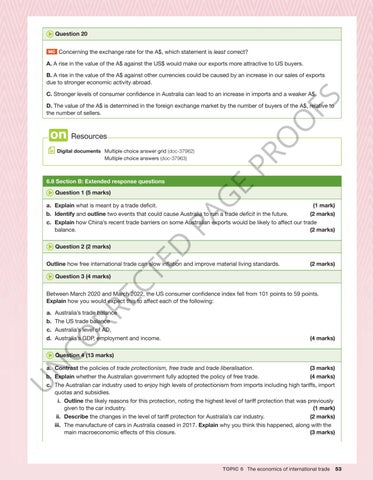“c06TheEconomicsOfInternationalTrade_PrintPDF” — 2022/5/31 — 13:29 — page 53 — #53
Question 20 MC
Concerning the exchange rate for the A$, which statement is least correct?
A. A rise in the value of the A$ against the US$ would make our exports more attractive to US buyers. B. A rise in the value of the A$ against other currencies could be caused by an increase in our sales of exports due to stronger economic activity abroad.
FS
C. Stronger levels of consumer confidence in Australia can lead to an increase in imports and a weaker A$.
O
D. The value of the A$ is determined in the foreign exchange market by the number of buyers of the A$, relative to the number of sellers.
O
Resources
Resourceseses
E
6.8 Section B: Extended response questions
PR
Digital documents Multiple choice answer grid (doc-37962) Multiple choice answers (doc-37963)
G
Question 1 (5 marks)
TE
Question 2 (2 marks)
D
PA
a. Explain what is meant by a trade deficit. (1 mark) b. Identify and outline two events that could cause Australia to run a trade deficit in the future. (2 marks) c. Explain how China’s recent trade barriers on some Australian exports would be likely to affect our trade balance. (2 marks)
Outline how free international trade can slow inflation and improve material living standards.
CO RR EC
Question 3 (4 marks)
(2 marks)
Between March 2020 and March 2022, the US consumer confidence index fell from 101 points to 59 points. Explain how you would expect this to affect each of the following: a. b. c. d.
Australia’s trade balance The US trade balance Australia’s level of AD, Australia’s GDP, employment and income.
(4 marks)
N
Question 4 (13 marks)
U
a. Contrast the policies of trade protectionism, free trade and trade liberalisation. (3 marks) b. Explain whether the Australian government fully adopted the policy of free trade. (4 marks) c. The Australian car industry used to enjoy high levels of protectionism from imports including high tariffs, import quotas and subsidies. i. Outline the likely reasons for this protection, noting the highest level of tariff protection that was previously given to the car industry. (1 mark) ii. Describe the changes in the level of tariff protection for Australia’s car industry. (2 marks) iii. The manufacture of cars in Australia ceased in 2017. Explain why you think this happened, along with the main macroeconomic effects of this closure. (3 marks)
TOPIC 6 The economics of international trade
53





















































